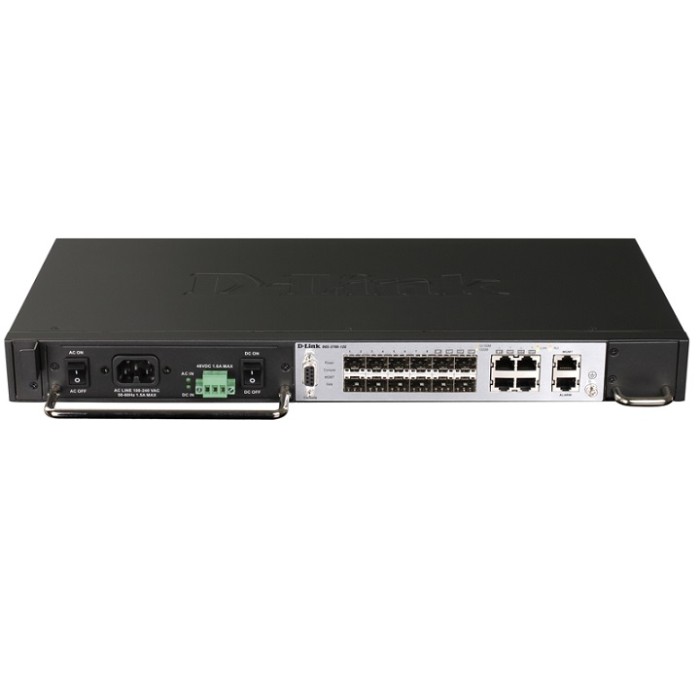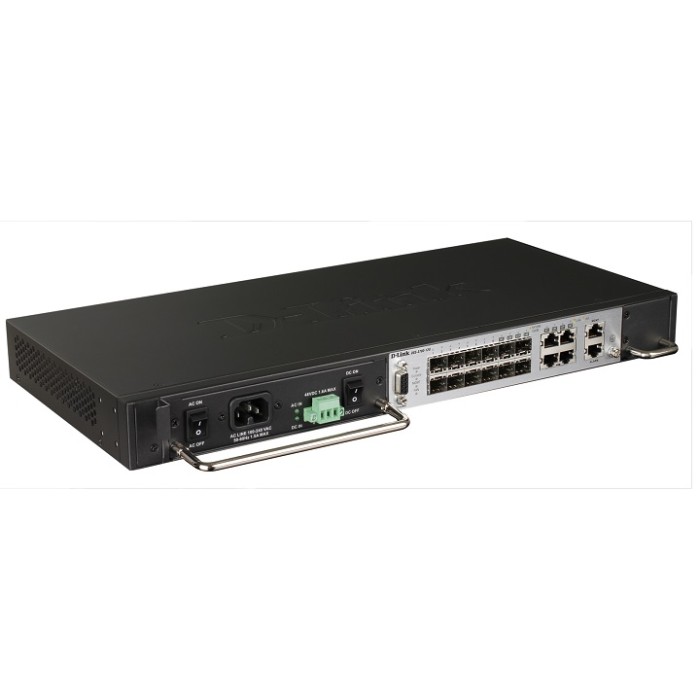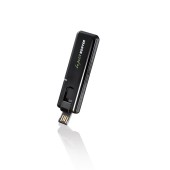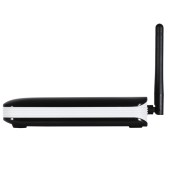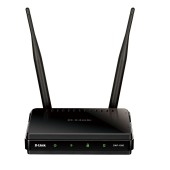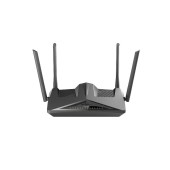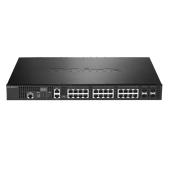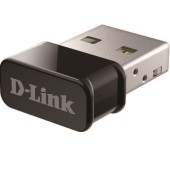D-Link DGS-3700-12G 8-Port Gigabit SFP ports Managed L2 Switch with 4 combo SFP ports
D-Link DGS-3700-12G 8-Port Gigabit SFP ports Managed L2 Switch with 4 combo SFP ports
SPECIFICATION
Interfaces
- 8 SFP-ports
- 4 Combo 10/100 / 1000BASE-T / SFP
- 1 console port RS-232
- 1 control port RJ-45
- Signal 1 RJ-45 port
Modular components
- Filter for dust removal
- Fan
- Power supply AC / DC
Performance
- Switching Matrix: 24Gbit / s
- Speed ??packet forwarding: 17,86Mpps
- Packet buffer: 1MB
- MAC address table: up to 16K entries
- Size Jumbo-frames: 13312 Byte
Layer 2 functions
- Virtual Stacking
- MAC-address table: 16K
- Flow control:
- Flow control 802.3h
- Prevent blocking HOL
- Jumbo-size frames to 13312 Byte
- Spanning Tree:
- 802.1D STP
- 802.1w RSTP
- 802.1s MSTP
- BPDU Filtering
- Root Restriction
- Loopback Detection is
- Link Aggregation 802.3ad (LACP)
- Max. 6 groups per device / 8 Gigabit ports per group
- Port Mirroring:
- One-to-One
- Many-to-One
- Mirroring flow-based
- Mirroring RSPAN *
- E-RPS * (Ethernet Ring Protection Switching)
- Layer 2 Tunneling Protocol
Multicast Layer 2
- IGMP Snooping:
- IGMP v1 / v2 / v3 Snooping
- Support for IGMP groups do1K
- IGMP Snooping Fast Leave
- Host-Based IGMP Fast Leave
- IGMP / MLD Proxy Reporting
- Filtering IGMP / MLD
- Up to 60 profiles filtering IGMP, 128 bands on profile
- MLD Snooping:
- MLD v1 Snooping
- MLD v2 Snooping *
- Supports up to 1K MLD snooping groups
- MLD Snooping Fast Leave
VLAN
- Group VLAN:
- Max. the number of groups of static VLAN: 4K
- Max. the number of groups of dynamic VLAN: 2K
- VLAN Trunking
- VLAN-based protocol 802.1v
GVRP
- Double VLAN (Q-in-Q):
- Port-Based Q-in-Q
- Selective Q-in-Q
- Voice VLAN *
- VLAN based on MAC addresses
- Guest VLAN
Quality of Service (QoS)
- Quality of Service (QoS) 802.1p
- 8 queues
- CoS based on:
- Port Switch
- VLAN ID
- 802.1p priority queues
- MAC address
- Addresses IPv4 / v6
- DSCP
- The type of protocol
- Traffic class Iv6
- Tags IPv6 flow
- TCP / UDP port
- Contents of the package, a user-defined
- 3-color marker
- TrTCM
- SrTCM
- Congestion control:
- SRED
- Support for the following operations for the streams:
- Changing the 802.1p priority tag
- Change the tag TOS / DSCP
- Bandwidth Management
- Statistics flow
- Committed Information Rate (CIR), in increments of 64 kbit / s
- Bandwidth Management:
- Based on the port (incoming / outgoing, min. Step 64 kb / s)
- On the basis of the flow (incoming / outgoing, min. Step 64 kb / s)
Access Control Lists (ACL)
- To 1500 access rules
- ACL based on:
- 802.1p priority queues
- VLAN ID
- MAC address
- Ether Type
- Addresses IPv4 / v6
- DSCP
- The type of protocol
- Non-TCP / UDP port
- Class IPv6 traffic
- Tags IPv6 flow
- Contents of the package, a user-defined (PCF)
- Time-Based ACL
- CPU Interface Filtering
- Statistics ACL
Security
- SSH v1 / v2
- SSL v1 / v2 / v3
- Function Port Security: up to 128 MAC addresses per port / VLAN
- Broadcast / multi-address / unicast storm
- Traffic Segmentation
- IP-MAC-Port Binding:
- Support for 500 entries per device
- Supports ARP / ACL / Auto (DHCP Snooping)
- Function D-Link Safeguard Engine
- Preventing ARP Spoofing
- DHCP Server Screening
- DHCP Client Filtering
- Protection against attacks BDPU
- Filtering NetBIOS / NetBEUI
AAA
- 802.1X:
- Based Access Control port
- Based Access Control host
- Assigning dynamic VLAN
- Based Access Control Web (WAC):
- Based Access Control port
- Based Access Control host *
- Assigning dynamic VLAN
- Access control based on MAC addresses (wt):
- Based Access Control port
- Based Access Control host *
- Assigning dynamic VLAN
- Microsoft® NAP (Supports IPv4 / v6)
- Authentication servers through RADIUS and TACACS +
- Three-level system of user authorization
- Maintain accounts via RADIUS
Operations, Administration and Management (OAM)
- Loopback Diagnostic
- Diagnostic cable
- Management errors connections 802.1ag (CFM)
- Support for 64 MIP and MEP 32
- 802.3ah
- ITU-T Y.1731 *
- Optical Transceiver function Digital Diagnostic Monitoring (DDM)
Management
- Web-interface (Support IPv4 / v6)
- Command Line Interface CLI
- Server Telnet (Supports IPv4 / v6)
- Telnet-Client (Supports IPv4 / v6) *
- TFTP-client (Supports IPv4 / v6)
- XModem
- ZModem
- SNMP v1 / v2c / v3
- SNMP Traps
- System Log
- RMON v1
- Support groups 1,2,3,9
- RMON v2
- Support group ProbeConfg
- SFlow
- LLDP
- LLDP-MED *
- IPv6 Neighbor Discover (ND)
- BootP / DHCP-client
- DHCP automatically
- DHCP Relay Option 60
- DHCP Relay Option 61
- DHCP Relay Option 82
- DHCP-server *
- DNS Relay *
- DNS-client *
- File System Flash (Flash File System) *
- Support for two copies of the Software (Dual Image)
- Support for two copies of the configuration (Dual Confguration)
- Monitoring CPU +
- Diagnostic cable
- SNTP
Technology D-Link Green
- RoHS Compliant 6
- Power Save Mode *
- Status disable connection
MIB
- RFC1155, 2578 Structure of the MIB
- RFC1212 MIB Definition
- RFC1213 MIBII
- RFC1493 Bridge MIB
- RFC1901 ~ 1908 SNMPv2 MIB
- RFC1757, 2819 RMON MIB
- RFC2021 RMONv2 MIB
- RFC1643, 2358, 2665 Ether-like MIB
- RFC 2668 802.3 MAU MIB *
- RFC2674 Q-Bridge / P-Bridge MIB
- RFC2674 802.1p MIB
- RFC2233, 2863 IF MIB
- RFC2618 RADIUS Authentication Client MIB
- IGMPv3 MIB
- RFC4022 MIB for TCP
- RFC4113 MIB for UDP
- RFC3298 MIB for Diffserv
- RFC2620 RADIUS Accounting Client MIB
- Ping MIB
- Traceroute MIB *
- Running Confguration MIB
- TFTP Update / Download MIB
- DDM MIB
- RFC2465 IPv6 MIB
- RFC2466 ICMPv6 MIB
- RFC4292 IP FDB MIB
- RFC4293 IPv6 SNMP management interface MIB
- D-Link Private MIB
Compliance with standards
- RFC768 UDP
- RFC791 IP
- RFC792 ICMPv4
- RFC2463 ICMPv6
- RFC4884 Extended ICMP
- RFC793 TCP
- RFC826 ARP
- RFC1981 Path MTU Discovery for IPv6
- RFC2460 IPv6
- RFC2461, 4861 IPv6 ND
- RFC2462 IPv6 Stateless Address
- Auto-configuration
- RFC2464 IPv6 over Ethernet and Definition
- RFC4291 IPv6 Address Architecture
- RFC4213 IPv4 / IPv6 Dual Stack
- RFC2474, 3168, 3260 IPv6 Differentiated Services Field
- * This function will be available in future versions of the software
Power Supply (Modular)
- + AC 100 ~ 240V, 50/60 Hz
- + DC 36 ~ 75V @ 3A (max.)
Power consumption (max.)
- + AC: 42.1 W
- + DC: 30,3 W
Dimensions
- 441h210h44 mm
Width
- For installation in 19-inch rack, 1U size
Weight
- 3.4 kg
Working temperature
- From 0 ° to 65 ° C
Storage temperature
- From -40 ° to 70 ° C
Working Humidity
- From 10% to 90% (non-condensing)
Humidity Storage
- From 5% to 90% (non-condensing)
Electromagnetic safety
- FCC Class A, CE, C-Tick, VCCI
Security
- cUL, CB
- MTBF
- 298 611chasov
Certifications
- MEF9, 14
Related Product
Connect to high-speed wireless networks with the D-Link AC1300 MU-MIMO Wi-Fi Nano USB Adapter. The DWA-181 uses wireless AC1300 technology which provides increased speed and range over the 802.11ac standard, giving you a faster, more reliable wireless connection. With speeds of up to 867 Mbps (5 Ghz) or 400 Mbps (2.4 Ghz)1, this is an excellent, affordable solution for everyday activities such as transferring large files, browsing the Internet, and downloading high-definition multimedia.

